Plakin Expression in Serous Epithelial Ovarian Cancer Has the Potential to Impede Metastatic Spread and Epithelial-Mesenchymal Transition: A Comparative Expression Analysis of Immunohistochemical and In Silico Datasets
- PMID: 39682273
- PMCID: PMC11639978
- DOI: 10.3390/cancers16234087
Plakin Expression in Serous Epithelial Ovarian Cancer Has the Potential to Impede Metastatic Spread and Epithelial-Mesenchymal Transition: A Comparative Expression Analysis of Immunohistochemical and In Silico Datasets
Abstract
Epithelial ovarian cancer is aggressive and causes high mortality among women worldwide. Members of the plakin family are essential to maintain cytoskeletal integrity and key cellular processes. In this study we characterised the expression of plakins, particularly plectin (PLEC), periplakin (PPL), envoplakin (EVPL), and EMT-related proteins by immunohistochemistry in n = 48 patients' samples to evaluate a potential correlation of plakin expression with EMT as EOC progresses. These tissue plakin and EMT expression analyses were further evaluated by in vitro cell line expression and correlated with the expression of these molecules using publicly available datasets such as Cancer Genome Atlas (TCGA) and Clinical Proteome Tumour Analysis Consortium (CPTAC) datasets. We demonstrate that the expression of PPL and PLEC plakins is decreased in high-grade compared to low-grade EOCs with mixed EMT marker protein expression. This is supported by the correlation of high PPL and PLEC expression with an epithelial rather than mesenchymal phenotype. Our data suggest a partial loss of plakin expression as EOC tumours progress. This may impact the connections of plakins with membrane-bound receptors, which impede the downstream signalling required for the initiation of EMT as the tumours progress.
Keywords: ascites; epithelial ovarian cancer; epithelial–mesenchymal transition; in silico datasets; metastasis; plakins.
Conflict of interest statement
The authors declare no competing interests.
Figures


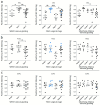

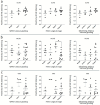
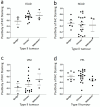










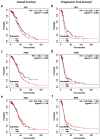
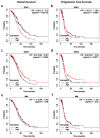

Similar articles
-
The attributes of plakins in cancer and disease: perspectives on ovarian cancer progression, chemoresistance and recurrence.Cell Commun Signal. 2021 May 17;19(1):55. doi: 10.1186/s12964-021-00726-x. Cell Commun Signal. 2021. PMID: 34001250 Free PMC article. Review.
-
The members of the plakin family of proteins recognized by paraneoplastic pemphigus antibodies include periplakin.J Invest Dermatol. 1998 Aug;111(2):308-13. doi: 10.1046/j.1523-1747.1998.00279.x. J Invest Dermatol. 1998. PMID: 9699735
-
Loss of periplakin expression is associated with the tumorigenesis of colorectal carcinoma.Biomed Pharmacother. 2017 Mar;87:366-374. doi: 10.1016/j.biopha.2016.12.103. Epub 2017 Jan 6. Biomed Pharmacother. 2017. PMID: 28068625
-
Unique role for the periplakin tail in intermediate filament association: specific binding to keratin 8 and vimentin.Exp Dermatol. 2002 Oct;11(5):428-38. doi: 10.1034/j.1600-0625.2002.110506.x. Exp Dermatol. 2002. PMID: 12366696
-
Plakins in development and disease.Exp Cell Res. 2007 Jun 10;313(10):2189-203. doi: 10.1016/j.yexcr.2007.03.039. Epub 2007 Apr 19. Exp Cell Res. 2007. PMID: 17499243 Review.
Cited by
-
Identification of Proteins Associated with Ovarian Cancer Chemotherapy Resistance Using MALDI-MSI.Int J Mol Sci. 2025 Jun 19;26(12):5893. doi: 10.3390/ijms26125893. Int J Mol Sci. 2025. PMID: 40565351 Free PMC article.
References
-
- Bray F., Laversanne M., Sung H., Ferlay J., Siegel R.L., Soerjomataram I., Jemal A. Global cancer statistics 2022: GLOBOCAN estimates of incidence and mortality worldwide for 36 cancers in 185 countries. CA Cancer J Clin. 2024;74:229–263. - PubMed
-
- Latifi A., Escalona R., Quinn M.A., Thompson E.W., Findlay J.K., Ahmed N. Distinct molecular signature of recurrent ovarian tumor cells isolated from the ascites of advanced-stage serous ovarian cancer patients. J. Cancer Stem Cell Res. 2014;2:e10061-20. doi: 10.14343/JCSCR.2014.2e1006. - DOI
LinkOut - more resources
Full Text Sources
Miscellaneous

